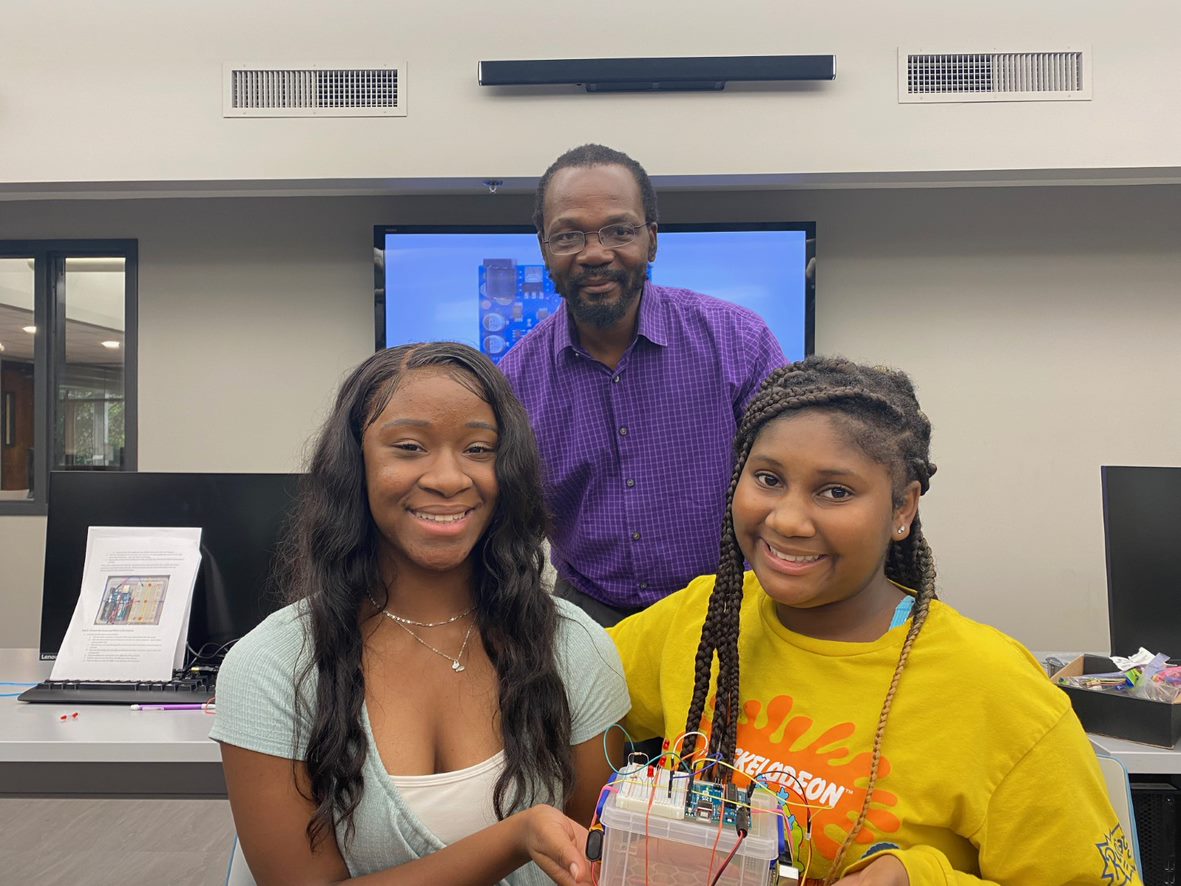The LSU SRP is Shining Light on Pollution!
The Shining Light on Pollution Environmental Health Literacy Program is a partnership between the LSU Superfund Research Program and Southern University.

The Shining Light on Pollution Environmental Health Literacy program is a unique opportunity for students to learn about air pollution and environmental health. The program is a partnership between the Louisiana State University Superfund Research Program (LSU SRP) and the Southern University (SU) Upward Bound program. It blends instruction about environmental health, toxicology, air pollution, and environmental justice with engaging hands-on activities. The program culminates in mentored group projects where students collect and present air quality data.

Two Shining Light on Pollution EHL program participants and Dr. Wesley Gray (back)
proudly display their DIY particulate matter (PM) sensor.Dr. Chuqi Guo
This year the workshop took place in person at Southern University and LSU from July 7 through July 12. Over 30 Upward Bound students attended and graduate students and postdoctoral researchers from the LSU SRP and SU's Environmental Toxicology Program served as mentors. One of the highlights of the program was a field trip to LSU's Inhalation Toxicology Laboratory.

Dr. Alexandra Noel with two Shining Light on Pollution EHL program participants during
a tour of the LSU Inhalation Toxicology Facility at the School of Veterinary Medicine.Dr. Wesley Gray
Another highlight was the group projects the participants completed. Led by their mentors, graduate student and postdoctoral trainees with the LSU SRP, the participants developed mini-projects based around a research question they could answer by collecting air quality data with hand-held, low-cost, particulate matter (PM) sensors. In addition to collecting the data, they learned how to analyze and present their results. Project topics included observations of PM in indoor versus outdoor environments, observations of PM in different outdoor environments across Baton Rouge, and observations of PM in the same location over time paired with data about weather and local activities. In addition to collecting the data, they learned how to analyze and present their results.
Contact
Jen Irving
LSU Superfund Research Program
Latest SRP News Feed
- Trainee Spotlight: Q&A with Fox Foley
- LSU SRP Co-Sponsors Science Communication Workshop, Hosts Spin-off Event for Trainees
- LSU SRP Researchers Awarded Grant to Study How Bushfire Smoke Harms Health
- Shining Light on Pollution: LSU SRP Partners with Southern University to Promote Environmental Health LiteracyFor the third year in a row, the Louisiana State University Superfund Research Program (LSU SRP) teamed up with Southern University to hold the Shining Light on Pollution Environmental Health Literacy Program. The program covers a wide range of topics related to air pollution and environmental health and also introduces students to different career paths in the environmental health sciences. High school students involved in Southern University's Upward Bound program are recruited to participate in the week-long program. Participants do not need to have any prior experience with research or STEM classes.
- LSU SRP Data Management & Analysis Core and Research Experience & Training Coordination Core Lead Statistical Workshop
- LSU SRP Open Forum Seminar on EPFRs and Human HealthThe Louisiana State University Superfund Research Program (LSU SRP) hosted three scientists who are experts in lung disease and the dangers of environmentally persistent free radicals (EPFRS) from the University of Queensland in Australia. These LSU SRP collaborators traveled to Baton Rouge to speak at the LSU SRP Open Forum Seminar on EPFRs and Human Health on May 25, 2023.






